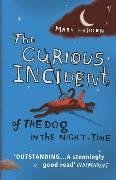All Nonfiction
- Bullying
- Books
- Academic
- Author Interviews
- Celebrity interviews
- College Articles
- College Essays
- Educator of the Year
- Heroes
- Interviews
- Memoir
- Personal Experience
- Sports
- Travel & Culture
All Opinions
- Bullying
- Current Events / Politics
- Discrimination
- Drugs / Alcohol / Smoking
- Entertainment / Celebrities
- Environment
- Love / Relationships
- Movies / Music / TV
- Pop Culture / Trends
- School / College
- Social Issues / Civics
- Spirituality / Religion
- Sports / Hobbies
All Hot Topics
- Bullying
- Community Service
- Environment
- Health
- Letters to the Editor
- Pride & Prejudice
- What Matters
- Back
Summer Guide
- Program Links
- Program Reviews
- Back
College Guide
- College Links
- College Reviews
- College Essays
- College Articles
- Back
The Curious Incident of the Dog in the NIght-Time by Jonathan Chern
Murder cases usually involve humans; who would have thought that an entire book, one that’s actually not bad, could have been written based on an over-curious boy with Asperger syndrome. Haddon, winner of the Whitbread Book of the Year Award in 2003 and winner of the Commonwealth Writers’ Prize Overall Best First Book for this book in 2004, originally wrote this book for an adult audience. Fortunately, this book is equally interesting for adults and children. Haddon, a British novelist and poet who grew up in Northampton, is known for his series of Agent Z books and for writing both the screenplay for Fungus the Bogeyman in 2001 and Coming down the Mountain in 2007.
The novel begins with a few details at the crime scene and gives the base reason for why this book’s written. Straight from the beginning, one can note Haddon’s style. Because he writes from the perspective of an autistic boy, the book has a very simple and endearing style; it’s simple and makes perfect complete sense. Towards the beginning, “Siobhan said that the book should begin with something to grab people’s attention. That is why I started with the dog. I also started with the dog because it happened to me and I find it hard to imagine things which did not happen to me” (5). The sentences are simple and the reader can tell it’s written from the perspective of an autistic boy; what’s incredible is the fact that it makes complete sense throughout and is entertaining enough to keep readers of all ages hooked. Furthermore, the novel’s unique in its own way; the book is laced with anecdotes, intelligent comments, and other tangents that branch off and yet still tie and contribute meaning to the novel.
As the book continues on, the readers given insight into Christopher John Francis Boone, our young autistic detective’s…well “detective’s” thoughts and how his mind works. The reader learns of simple stuff such as the fact that he doesn’t love metaphors, can’t lie, and that “4 red cars in a row made it a good day, and 3 red cars in a row made it a quite good day, and 5 red cars in a row made it a super good day, and why 4 yellow cars in a row made it a black day…” (24). I believe Chris’s thoughts are crucial in understanding him and eventually provide as a justification to his actions once he discovers an incredible secret involving his parents. Haddon furthermore makes readers connect to certain characters. Chris’s father is portrayed as one of the more real characters and truly shows his love and devotion to his son. After losing his son’s trust accidentally, Chris’s father apologizes and declares that “You have to learn to trust me…And I don’t care how long it takes…If it’s a minute one day and two minutes the next and three minutes the next and it takes years I don’t care. Because this is important” (218). Haddon portrays Chris’s father as pretty realistic; he apologizes for actions he didn’t mean to commit.
One of the best qualities in Haddon’s expertise is his ability to reveal something big halfway through the book, and yet continue to write. Let me explain. Haddon reveals who murders the dog halfway through the story, the whole purpose of the book, and uses it to reveal something so secret it can tear families apart.
Of the numerous books I’ve read, the only book(s) that I could possibly compare Haddon’s book to are the “Artemis Fowl” book series by Eoin Colfer. Both are simple and make complete sense. More importantly, both make the reader want to read more; Haddon makes the reader want to know what happened while Colfer intrigues the reader(s) with pure intelligence and magic.
This book won the Commonwealth Writers’ Prize Overall Best First Book for a reason, however despite its numerous admirable qualities, I believe this book just like others has its “pros and cons”. Haddon successfully incorporates an autistic boy’s feelings and thoughts into the book. He also makes certain characters such as Chris’s father connect with the reader; his father However, the reader could become frustrated with the book; Chris’s actions might frustrate the reader or we might whine and groan at the pace of the action. However fitting the random tangents on this book are, I do believe that Haddon could have sped up the action of the book a little bit so the reader(s) don’t become frustrated with the over simplistic style of this book. But overall, this book is extremely entertaining and will bring any reader into our intelligent detective’s world.
Similar Articles
JOIN THE DISCUSSION
This article has 1 comment.


3 articles 4 photos 25 comments